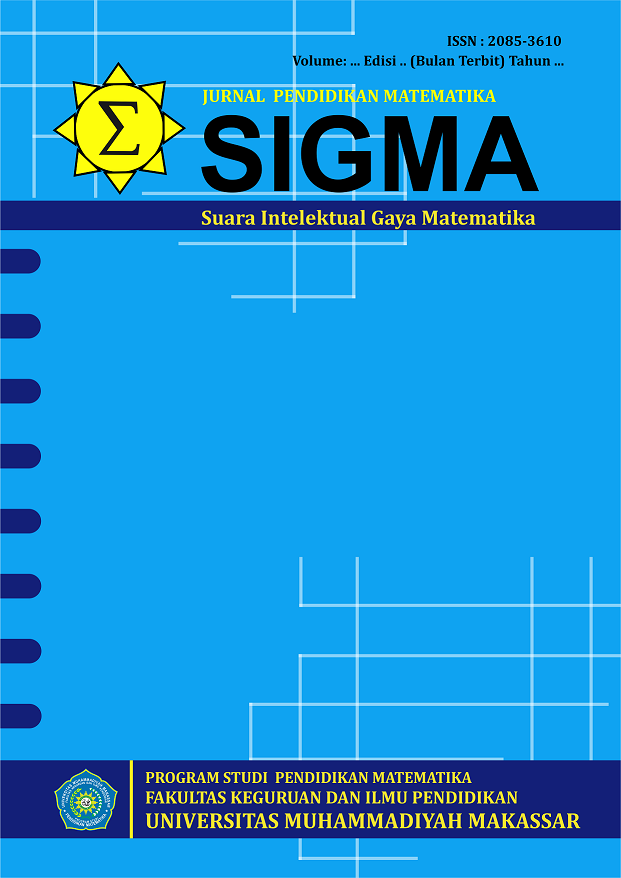KEMAMPUAN PEMECAHAN MASALAH MATEMATIS SISWA SMP DI KAMPUNG CIBOGO PADA MATERI SPLDV
DOI:
https://doi.org/10.26618/sigma.v13i2.5812Keywords:
Problem-solving skills, SPLDV, qualitative research, junior high school students, Cibogo villageAbstract
Problem-solving is one of the skills that must be possessed by every student, especially in learning mathematics. By having problem-solving skills, students can solve every problem well in every field. The results of previous studies show that the ability to solve mathematical problems is still low, especially in the SPLDV material. This study aims to determine the mathematical problem-solving ability of junior high school students on the SPLDV material. This research is qualitative research, with the research sample is junior high school students in Cibogo village. Sampling was done randomly and randomly selected four students. The data collection techniques used were observation, tests, and interviews, while the data analysis techniques used data reduction, data presentation, and conclusion drawing/verification. The results showed that students' mathematical problem-solving abilities were still low, seen from the percentage of the results of the analysis of students' mathematical problem-solving abilities, namely the percentage of the first indicator, namely identifying the known elements, which were asked and the adequacy of the required elements, the percentage of the first sub was 100%. While in the second sub, the percentage is 0%. Furthermore, in the second indicator, namely formulating mathematical problems or compiling mathematical models, the first sub percentage is 75% the same as the second sub the percentage is 75%. Then on the third indicator, namely choosing and setting strategies to solve problems inside or outside mathematics, the first sub percentage is 0%, as well as the second sub percentage, is 0%. And in the fourth indicator, namely explaining or interpreting the results according to the original problem and checking the correctness of the results or answers, the first sub percentage is 25%, and in the second sub, the percentage is 25%.References
Afriansyah, E. A. (2021). Realistic Mathematics Education Berbasis Emergent Modeling untuk Meningkatkan Kemampuan Berpikir Kritis dan Kreatif Matematis serta Curiosity Mahasiswa Calon Guru (Doctoral dissertation, Universitas Pendidikan Indonesia).
Afriansyah, E. A., Herman, T., & Dahlan, J. A. (2021, February). Critical thinking skills in mathematics. In Journal of Physics: Conference Series (Vol. 1778, No. 1, p. 012013). IOP Publishing.
Alcantara, E. C., & Bacsa, J. M. P. (2017). Critical thinking and problem-solving skills in mathematics of grade-7 public secondary students. Asia Pacific Journal of Multidisciplinary Research, 5(4), 21-27.
Fitria, N. F. N., Hidayani, N., Hendriana, H., & Amelia, R. (2018). Analisis Kemampuan Pemecahan Masalah Matematik Siswa SMP dengan Materi Segitiga dan Segiempat. Edumatica: Jurnal Pendidikan Matematika, 1(8), 49-57.
Hannula, M. S., Pantziara, M., & Di Martino, P. (2018). Affect and mathematical thinking: Exploring developments, trends, and future directions. Developing Research in Mathematics Education Twenty Years of Communication, Cooperation and Collaboration in Europe.
Latifah, T., & Afriansyah, E. A. (2021). Kesulitan dalam Kemampuan Pemecahan Masalah Matematis Siswa pada Materi Statistika. Journal of Authentic Research on Mathematics Education (JARME), 3(2).
Masfufah, R., & Afriansyah, E. A. (2021). Analisis Kemampuan Literasi Matematis Siswa melalui Soal PISA. Mosharafa: Jurnal Pendidikan Matematika, 10(2), 291-300.
Mulyanti, N. R., Yani, N., & Amelia, R. (2018). Analisis Kesulitan Siswa dalam Pemecahan Masalah Matematik Siswa SMP pada Materi Teorema Phytagoras. Jurnal Pembelajaran Matematika Inovatifi, 1(3), 415-426.
Nurhasanah, D. E., Kania, N., & Sunendar, A. (2018). Penggunaan Model Pembelajaran Discovery Learning untuk Meningkatkan Kemampuan Pemecahan Masalah pada Siswa SMP. Jurnal Didactical Mathematics, 1(1), 21-32.
Oftiana, S., & Saefudin, A. A. (2017). Pengaruh pendekatan pembelajaran matematika realistik indonesia (PMRI) terhadap kemampuan pemecahan masalah matematika siswa kelas VII smp negeri 2 srandakan. Jurnal Matematika dan Pembelajaran, 5(2), 293-301.
Olivares, D., Lupiáñez, J. L., & Segovia, I. (2021). Roles and characteristics of problem solving in the mathematics curriculum: a review. International Journal of Mathematical Education in Science and Technology, 52(7), 1079-1096.
Pakpahan, N. A., & Hasruddin, H. (2021). Kemampuan Literasi Materi Sistem Gerak Siswa SMA pada Masa Pandemi Covid-19. Jurnal Review Pendidikan dan Pengajaran, 4(1), 162-172.
Putra, H. D., Thahiram, N. F., Ganiati, M., & Nuryana, D. (2018). Kemampuan Pemecahan Masalah Matematis Siswa SMP pada Materi Bangun Ruang. Jurnal Ilmiah Pendidikan Matematika, 6(2), 82-84.
Sugiyono. (2018). Metode Penelitian Pendidikan Matematika. Bandung: Alfabeta.
Ulvah, S., & Afriansyah, E. A. (2016). Kemampuan pemecahan masalah matematis siswa ditinjau melalui model pembelajaran SAVI dan konvensional. Jurnal Riset Pendidikan, 2(2), 142-153.
Yuwono, T., Supanggih, M., & Ferdiani, R. D. (2018). Analisis Kemampuan Pemecahan Masalah Matematika dalam Menyelesaikan Soal Cerita Berdasarkan Prosedur Polya. Jurnal Tadris Matematika, 2(1), 137-144.
Downloads
Published
Issue
Section
License
With the receipt of the article by the SIGMA: Jurnal Pendidikan Matematika Editorial Board and the decision to be published, then the copyright regarding the article will be diverted to SIGMA: Jurnal Pendidikan Matematika.
Universitas Muhammadiyah Makassar as the publisher of SIGMA: Jurnal Pendidikan Matematika hold the copyright regarding all the published articles in this journal.Universitas Muhammadiyah Makassar has the right to multiply and distribute the article and every author is not allowed to publish the same article that was published in this journal.
The manuscript authentic and copyright statement submission can be downloaded ON THIS FORM.






